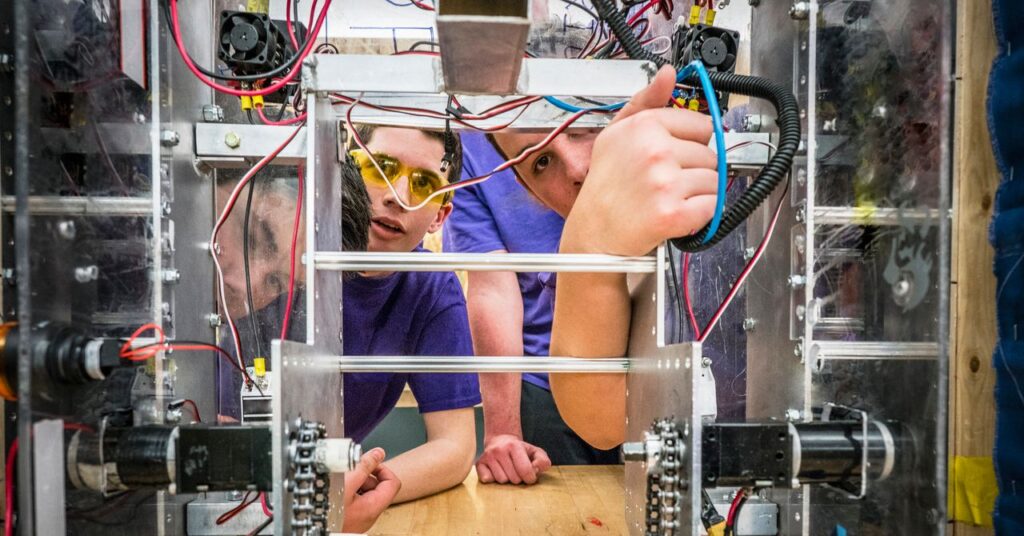
The Influence of AI on STEM Education for High School Students
In the past, pursuing a computer science degree guaranteed a promising career in the tech industry. However, today’s students are being guided by AI towards fields that merge computing with analysis, interpretation, and data.
In the early 2010s, every college-bound student interested in STEM was advised to learn coding, as Python was likened to modern-day Latin and computer science seemed like a secure path to a well-paying job. Fast forward to 2025, and the allure has faded. The once-popular mantra of “learn to code” now echoes sentiments similar to “learn shorthand.” While teenagers still aspire to work in technology, they no longer see coding as the sole gateway. With AI poised to take over coding roles and limited options for advanced placement classes in coding techniques, educators are striving to keep up.
According to Benjamin Rubenstein, an assistant principal at Manhattan Village Academy in New York City, there has been a shift from prioritizing computer science courses to emphasizing statistics classes. Rubenstein, with two decades of experience in teaching, has witnessed the transformation of the traditional “STEM pipeline” into a network of diverse educational paths rather than a linear trajectory. For his students, mastering statistics is seen as more pragmatic.
Decades ago, students inspired by NASA aspired to become physicists or engineers. Subsequently, the tech boom led many towards computer science careers at major companies like Google. However, today’s ambitions are molded by AI, guiding students away from tasks AI can perform (like coding) towards areas where it still struggles. With a decline in the number of students pursuing computer science degrees, high schoolers inclined towards STEM are exploring disciplines that integrate computing with data analysis and interpretation.
While Rubenstein insists on every student completing a computer science course before graduation for a foundational understanding, his school’s math department now combines data literacy with real-world applications through courses like Applied Mathematics that involve analyzing NYPD data for policy recommendations and an Ethnomathematics class linking math concepts with cultural contexts.
This shift towards multidisciplinary learning is not occurring in isolation. Universities are observing a plateau in the demand for computer science degrees after years of growth. According to the Computing Research Association, there was a 5.5 percent decrease in the number of computer science-related degrees awarded in the US and Canada during the 2023–2024 academic year.
At the high school level, there is a noticeable interest in data-related subjects. AP Statistics recorded over 264,000 exam registrations in 2024, making it one of the most popular AP tests. Although AP computer science exams continue to attract substantial numbers of students each year, data literacy is increasingly being viewed as equally important alongside coding skills.
Rubenstein emphasizes that students pursuing STEM fields will gravitate towards skills that enhance their employability. As workplace demands evolve, K-12 education adapts accordingly based on industry needs.
With the rise of AI posing challenges for educators in preparing students for an AI-dominated future while preventing overreliance on technology for learning processes, Rubenstein envisions AI as a valuable tool rather than a replacement in STEM education. Implementing algorithms that assist teachers in identifying students’ comprehension levels or suggesting personalized projects aligned with their interests could revolutionize classroom learning experiences.
This paradigm shift mirrors changes observed among students moving towards understanding and utilizing technology rather than solely focusing on its development. Educators are exploring how AI tools can improve data literacy and provide personalized STEM instruction opportunities.
Researchers like Xiaoming Zhai at the University of Georgia are pioneering innovative approaches by developing AI assistants known as “multi-agent classroom systems” that engage with teachers and students to simulate scientific inquiry processes.
Zhai advocates for a new form of literacy that involves integrating AI into various disciplines rather than treating it as separate from STEM fields. He envisions future scientists leveraging algorithms akin to how researchers once used microscopes – for pattern recognition, hypothesis testing, and expanding knowledge boundaries.
The emphasis is shifting from coding proficiency toward understanding and collaborating effectively with machine intelligence. Zhai leads efforts to embed AI principles into science education curricula nationwide while promoting responsible use of this technology among students.
In schools like Rubenstein’s institution, where STEM education is evolving rapidly, traditional computer science courses coexist with forensic studies electives, sci-fi labs, and discussions on data ethics.
Rather than resisting AI’s influence, today’s STEM learners are adapting by learning how to interpret its functions critically and leverage its capabilities effectively – marking a significant evolution in educational priorities.
